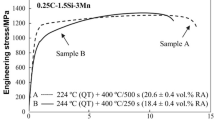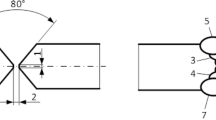Abstract
Commercial low-alloy structural steels, 0.45 pct C (AISI 1045 grade), 0.40 pct C-Cr-Mo (AISI 4140 grade), and 0.40 pct C-Ni-Cr-Mo (AISI 4340 grade), have been studied to determine the effect of the decreased hot-rolling reduction treatment (DHRRT) from 98 to 80 pct on fracture toughness of quenched and highly tempered low-alloy structural steels. The significant conclusions are as follows: (1) the sulfide inclusions were modified through the DHRRT from a stringer (mean aspect ratio: 16.5 to 17.6) to an ellipse (mean aspect ratio: 3.8 to 4.5), independent of the steels studied; (2) the DHRRT significantly improvedJ Ic in the long-transverse and shorttransverse orientations, independent of the steels studied; and (3) the shelf energy in the Charpy V-notch impact test is also greatly improved by the DHRRT, independent of testing orientation and steels studied; however, (4) the ductile-to-brittle transition temperature was only slightly affected by the DHRRT. The beneficial effect on theJ Ic is briefly discussed in terms of a crack extension model involving the formation of voids at the inclusion sites and their growth and eventual linking up through the rupture of the intervening ligaments by local shear.
Similar content being viewed by others
References
W. C. Leslie:Trans. Iron Steel Soc, 1983, vol. 2, pp. 1–24.
L. Luyckx, J.R. Bell, A. McLean, and M. Korchynsky:Metall. Trans., 1970, vol. 1, pp. 3341–50.
E. Spetzler and J. Wendorff:Proc. NOH-BOS, AIME, New York, NY, 1975, vol. 58, pp. 358–77.
J. J. Bosley and J. J. Oravec:Proc. NOH-BOS Conf., New York, NY, 1978, vol. 61, pp. 174-83.
T. B. Cox and J. R. Low, Jr.:Metall. Trans., 1974, vol. 5, pp. 1457–70.
G. Bernard, M. Grumbach, and F. Moliexe:Met. Technol., 1975, vol. 2, pp. 512–20.
R. Scott:Met. Technol., 1976, vol. 3, pp. 71–78.
Y. Tomita:Metall. Trans. A, 1988, vol. 19A, pp. 1555–61.
Annual Book of ASTM Standards, ASTM E813-81, ASTM, Philadelphia, PA, 1981, p. 762.
J. Hilliard and J. W. Cahn:Trans. TMS-AIME, 1961, vol. 221, pp. 344–52.
C.A. Clark and P. M. Munro:J. Iron Steel Inst., 1962, vol. 200, pp. 395–98.
Y. Tomita:Metall. Trans. A, 1987, vol. 18A, pp. 1495–1501.
F. A. McClintock: inFracture, H. Liebowittz, ed., Academic Press, New York, NY, 1971, vol. 3, pp. 47–225.
G. T. Hahn and A. R. Rosenfield:Metall. Trans. A, 1975, vol. 6A, pp. 653–68.
F. A. McClintock:Ductility, ASM, Metals Park, OH, 1968, pp. 255–77.
Metal Handbook, Japan Institute of Metal, ed., Japan, 1971, pp. 612–16.
A. G. Franklin and W. J. M. Tegart:J. Iron Steel Inst., 1964, vol. 202, pp. 588–92.
F. B. Pickering:Toward Improved Ductility and Toughness, Climax Molybdenum Corporation, Japan, 1971, pp. 9–31.
G. R. Speich and W. A. Spitzig:Metall. Trans. A, 1982, vol. 13A, pp. 2239–58.
Author information
Authors and Affiliations
Rights and permissions
About this article
Cite this article
Tomita, Y. Effect of decreased hot-rolling reduction treatment on fracture toughness of low-alloy structural steels. Metall Trans A 21, 2555–2563 (1990). https://doi.org/10.1007/BF02647001
Received:
Issue Date:
DOI: https://doi.org/10.1007/BF02647001




